World Class Coach Tom Byer on Why Soccer Starts At Home At An Early Age With Parents
Part II – Interview with Tom Byer
Tom Byer is a highly accomplished expert on player development. The Head Technical Advisor for the Chinese School Football Program Office and Official CSF Grassroots Ambassador, Byer runs his own soccer schools and is the author of the best selling book Soccer Starts At Home.
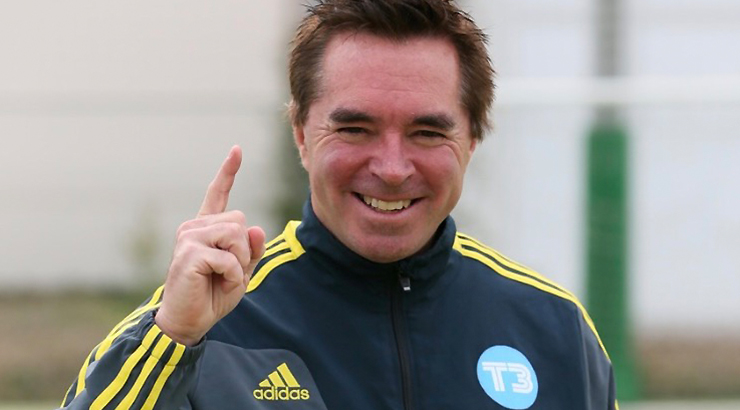
Tom Byer’s Soccer Starts At Home is a game-changer — A revolutionary approach to developing better soccer players in America.
This is what Harvard Medical School’s John J. Ratey, M.D., Associate Clinical Professor of Psychiatryth inks
Tom Byer is a world-class coach, developing players on the other side of the planet and wants to help American youth soccer players too.
Click to read Tom Byer Part I – SHOULD SOCCER START AT HOME? YES SAYS TOM BYER – HERE IS WHY
Born in the USA, Byer has lived and developed soccer players in Japan for over 30 years, ever since he hung up his professional cleats after playing in the Professional J League which is now the MLS equivalent.
Byer became a technical skills coach and is known as Tom-san in Japan. Many of Japan’s men’s and women’s national team players have benefited from his training. According to Byer, he is often contacted by many former and current professional players who tell him they grew up coming to his soccer schools, watching him on TV, and reading his books.

“The all-important entry level of the game — we do not get it right in America,”
said Byer.
Byer’s approach is to reach out to soccer parents before their kids start playing organized soccer.
Before a kid joins a team, he or she needs to learn some soccer basics — and these can be joyfully shared by his or her parents.
Diane Scavuzzo reached Tom Byer in Japan. Here is the SoccerToday Interiew:
Diane Scavuzzo: How long have you been training players in Japan?
Tom Byer: I am a Technical Coach and I have focused since 1989 on training and improving the technical ability of individual players between the ages of 6-years-old to 12-years old.
I’ve conducted over 2000 events for more than 500,000 Players.
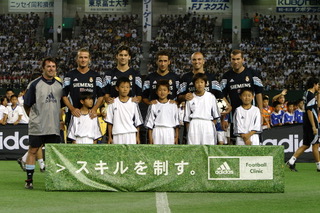
Real Madrid Players 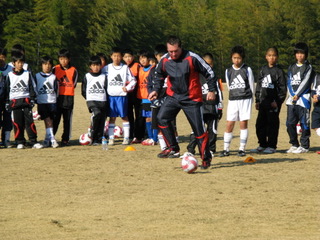
JFA National Training 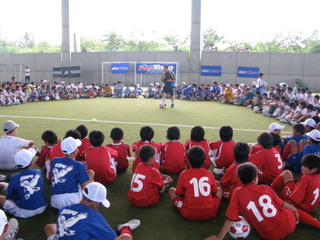
JPA National Tournament
In 1993, we set up a Soccer School business in Japan which focuses on technical skill development and is Japan’s largest program of its kind. Currently, there are 20,000 players throughout Japan in over 120 School locations.
Japan is made up of 47 different states and I’ve worked in every one of them over my 30-year span. The Japan Football Association also has 8 National Training Centers throughout Japan which I’ve worked in as well.
Diane Scavuzzo: You have trained many of Japan’s Men and Women National team players?
Tom Byer: Yes, I would imagine there would be very few professional players on either the Men’s or Women’s National Teams who have not been influenced by our work.
Currently, on Japan’s Men’s National Team two star players, Takumi Minamino and Ritsu Doan both attended my program starting when they were 6-years-old until the age of 12-years-old.

Byer with Takeshi Okada, Former Japan National Team Head Coach, 98’ & 2010 FIFA World Cup 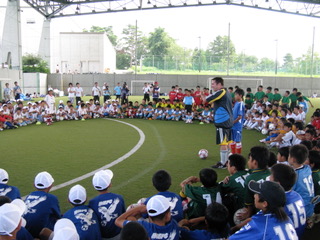
Bye at JFA National Training Center for the U12 National Tournament
On the Women’s side we have many National Team players who have also come through our programs and the current Head Coach, Asako Takakura, worked with me for several years.
Recently retired Japan Women’s National Team Captain, Aya Miyama, the 2011 World Cup Winner and three-time AFC Player of the Year came through our programs from a young age.
The Japan Women’s Teams are the only Team in the world that have won all 3 FIFA Tournaments, U17 World Cup, U20 World Cup, and Senior World Cup. They have also won the Silver Medal at the London Olympics. They did all this in a short span. Pretty remarkable for a country that only has approximately 50,000 Girls playing.
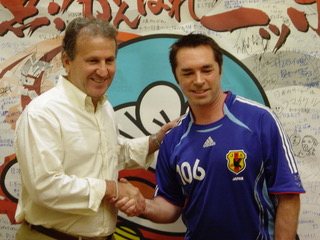
Byer with Zico, former Japan National Team Head Coach – 2006 FIFA World Cup 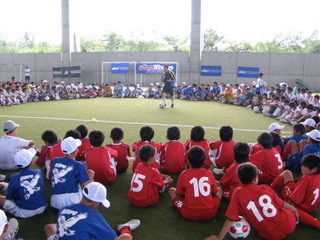
Byer training at the JFA Training Center
Diane Scavuzzo: Why do you think Japan is doing so well in soccer on the world stage?
Tom Byer: At the core of Japanese player development is the learning of technical skills — from a very young age — so they get the foundation phase correct.
They also train all year long so they practice more than most American players do.
The Japanese culture accepts that when a 6-year-old joins a youth soccer team, they will be expected to practice usually four times a week for 52 weeks. This, along with their very possession-based style, forms the characteristics of Japanese players.

Diane Scavuzzo: Why do you believe parents play such an important role in developing soccer talent in young players?
Tom Byer: Parents have a child opportunity to help their kids if they are properly informed.
Understanding the need for a child’s parental approval is critical. Kids are always seeking Mom and Dad’s approval and attention.
The interaction of showing them simple movements to do with a small soccer ball creates an electrical/chemical reaction called, “Emotions.” When a child is learning something in an “emotionally charged environment” this facilitates deep learning and long-term memory.
Kids practicing these technical moves are creating new neural pathways almost like uploading data to a hard drive that we call the brain.
It is is very difficult to replicate with a tiny young child with a group of twenty other kids with a strange coach. This is why the role of parents is crucial. They can provide a head start for their child before turning up to their first ever practice. This accelerates learning the game which also ensures the child is having fun from day one.
Parents need to understand that they just can’t drop off little Mary or Joey at a park a couple of times a week and expect they will start playing like Mia Hamm or Landon Donovan.
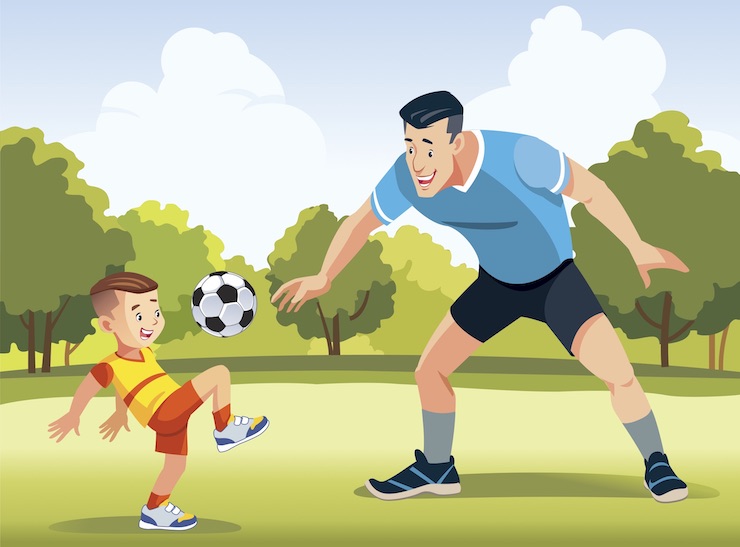
Parents often become the first teachers of the game.
When you study the best players in the world most of them started playing with a ball between the ages of two to five year old and the role of their parents is well documented. This includes Messi, Ronaldo, Iniesta, Suarez, Modric, Hazard, Pogba, Neymar — the list goes on with Donovan, Clint Dempsey, and Christian Pulisic and many others.
Parents are key because it’s more important that a child falls in love with the ball way before thinking about joining a youth soccer team.
A young child has little concept of being part of a team. The ball is at the center of a child’s universe in many of the traditionally strong soccer oriented countries. Kids around the world fall in love with the ball first and then with the game.
In America, we try to force kids to fall in love with the game when the ball gets in the way. There is a
This player will naturally have more fun, feel less intimidated, they’ll be more popular. Because of their comfort with the ball, the coach can ask them to demonstrate, so they’re getting leadership opportunities already at this young age. This is fantastic for a child’s confidence and self-esteem.
Diane Scavuzzo: There is a considerable difference in culture between our country and Japan…
Tom Byer: Yes, and if we’re talking about players age U7 and older, kids in Japan are perhaps more disciplined than their peers in the USA but teaching basic technical skills is just as important in America as it is overseas.
Is it Chaos? Visions of Soccer Starts At Home
Diane Scavuzzo: When people first hear about
Is this what they should picture?
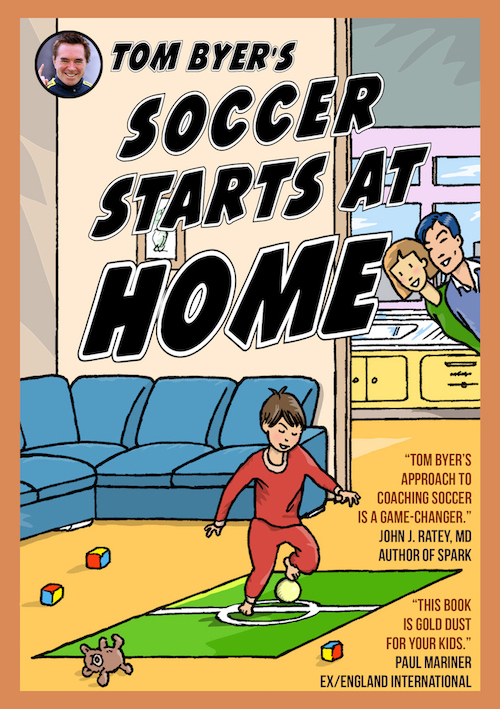
Tom Byer: Not at all. There’s no kicking of the ball, so it’s unlikely a young kid is going to break something. The ball is never in the air. Everything is done on the ground. After more than ten years of playing with both my sons inside the house, nothing was ever broken.
It takes educating people about our program. It is remarkable, but we get results very quickly. Its makes sense that kids who have already mastered the basic core skills such as stopping/starting, changing direction with a ball, cutting, turning and protecting the ball before joining a youth soccer team will enjoy their experience playing much more than others who just show up for their first practice who have never touched a ball.
It’s very difficult to teach tactics if the players don’t have the technical skill required to be able to execute. Technique surely makes learning soccer tactics easier.
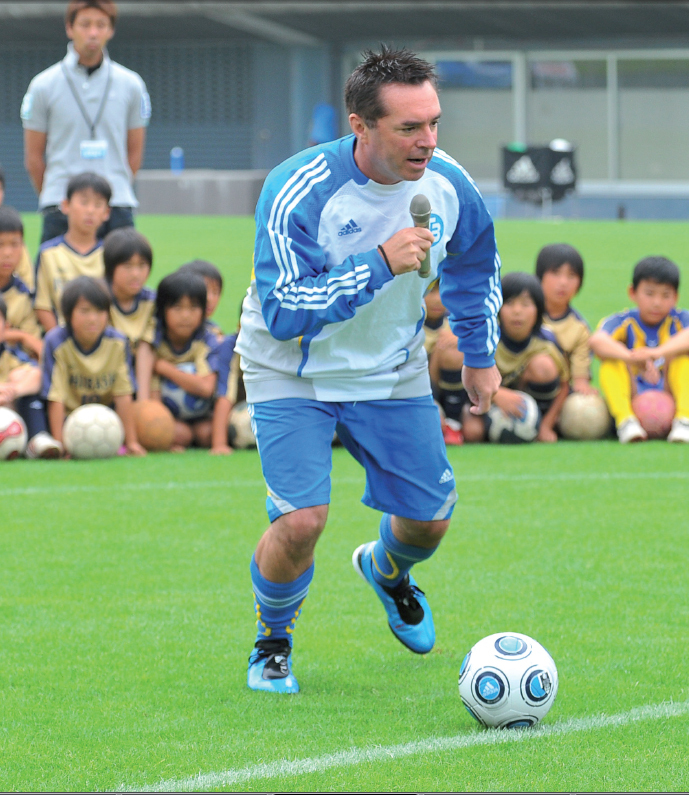
How does Soccer Starts At Home Keep Kids in the Game?
Diane Scavuzzo: You have said you could help stop the flood of kids leaving the sport. Can you explain?
Tom Byer: Common sense dictates it’s probably not the best players who are dropping out of the game in record numbers.
It is likely the players who are not having fun because they never learned the building blocks for successfully playing the game — and this often creates very impatient and irritated parents as well.
Parents are the game changer. This isn’t rocket science.
This is especially true when parents are paying significant sums of money for their children to participate in youth soccer and spending their time driving them back and forth between practices, games, and tournaments.
Of course, it is frustrating to see a player who can’t transfer the ball from right foot to left. Then these adults become the ugly parents, yelling at their kids from the sidelines when the child has absolutely no chance of doing anything differently since they don’t have the tools to execute anything they are trying to do with their feet with the exception of just kicking the ball.
Then it’s the youth soccer coaches who are blamed because the players are not skillful.
It’s like a revolving door of pointing fingers at everyone. Many problems are solved when you develop skilled technical players from a very young age.
“Not only is it a revolution, it is a revelation — Tom’s belief that in order to improve a class or team, you must raise the lower level rather than develop the high achievers is wisdom I never expected to find in a book about soccer,”
Professor John J. Ratey, M.D., Associate Clinical Professor of Psychiatry Harvard Medical School
Read: Renowned soccer trainer Tom Byer brings “Soccer Starts at Home” philosophy to Houston
Click to read Tom Byer Part I – SHOULD SOCCER START AT HOME? YES SAYS TOM BYER – HERE IS WHY





